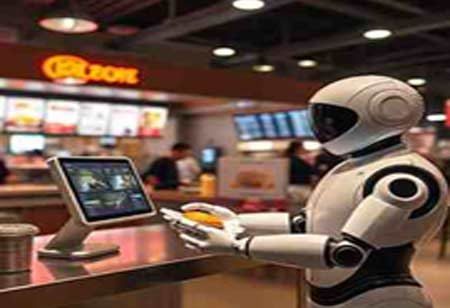THANK YOU FOR SUBSCRIBING
Be first to read the latest tech news, Industry Leader's Insights, and CIO interviews of medium and large enterprises exclusively from Food and Beverage Tech Review
Food Robotics Driving the Future of European QSRS
As European QSRs continue to embrace robotics, balancing efficiency, consumer trust, and regulatory compliance will be crucial to long-term success in this evolving industry.

By
Food and Beverages Tech Review | Thursday, March 20, 2025
Stay ahead of the industry with exclusive feature stories on the top companies, expert insights and the latest news delivered straight to your inbox. Subscribe today.
FREMONT, CA: The landscape of quick-service restaurants (QSRs) in Europe is undergoing a significant transformation, with food robotics at the forefront of this evolution. Driven by factors like labour shortages, increasing consumer demands for speed and consistency, and the need for enhanced hygiene, the adoption of robotic solutions is accelerating.
Europe's QSR industry is increasingly turning to robotics to address persistent labour. Automation through robotics fills workforce gaps and ensures consistent service, particularly during peak hours. Enhanced efficiency and speed are key benefits, as robots perform repetitive tasks precisely, reducing order processing times and improving overall throughput. Additionally, robotic systems contribute to improved hygiene and food safety by minimising human contact with food, thereby reducing contamination risks—an essential factor in today's health-conscious environment.
Robotic Applications and Market Considerations in European QSRs
Integrating robotics in Quick Service Restaurants (QSRs) is expanding beyond basic automation, with advanced applications enhancing efficiency, hygiene, and customer experience. Automated cooking stations are evolving to handle complex culinary tasks, such as precisely controlling cooking temperatures and times for dishes like stir-fries and pasta. Companies are leveraging sensor technologies, including thermal imaging and optical sensors, to monitor food quality in real time, ensuring consistency and preventing overcooking or undercooking. Robotic beverage dispensers are also gaining traction, with coffee robots capable of intricate latte art and cocktail machines delivering precise, high-quality mixed drinks—particularly valuable in high-volume hospitality settings.
Hygiene and operational efficiency are further improved through automated dishwashing and cleaning systems, which reduce labour costs and enhance sanitation. Some cleaning robots now incorporate UV-C light disinfection to eliminate bacteria and viruses, ensuring a safer environment. Robotic delivery systems are also advancing, with ground-based delivery robots increasingly used to navigate sidewalks and deliver food directly to customers, reducing delivery times and costs. While drone deliveries face regulatory hurdles in Europe, autonomous in-restaurant table delivery solutions are also under development.
Artificial intelligence (AI) and machine learning are pivotal in optimising QSR operations. AI-powered systems are being utilised to streamline kitchen workflows, predict demand, and minimise food waste. Machine learning algorithms analyse customer data to personalise menu recommendations and enhance order accuracy, while computer vision ensures food quality control by detecting ingredient inconsistencies.
Regulatory and Ethical Considerations
As robotic solutions become more widespread, European regulatory bodies are working to establish food safety regulations that ensure robotic food preparation meets stringent hygiene and sanitation standards. Additionally, labour displacement and job creation concerns must be addressed, as automation reduces reliance on human workers while simultaneously creating opportunities in robot maintenance, programming, and data analysis. Governments and businesses must invest in workforce training programs to facilitate this transition.
Data privacy is another key concern, as robotic systems collect extensive customer data. Ensuring compliance with GDPR and other data protection laws is essential to maintaining consumer trust. Furthermore, accessibility and inclusivity must be considered, with voice-activated ordering systems and assistive technologies helping to make automated QSRs more inclusive for individuals with disabilities.
Economic Impact and Investment
The European food robotics sector is experiencing significant venture capital investment, particularly in companies innovating in automated cooking, delivery, and food safety. QSRs assess robotics's return on investment (ROI), factoring in labour cost savings, operational efficiency, and customer satisfaction. Long-term cost reductions and revenue growth drive adoption, while supply chain optimisation through robotics—such as automated warehousing and robotic sorting—further enhances efficiency and minimises waste.
Consumer Perception and Market Acceptance
Despite the advantages of automation, some consumers value the "human touch" in dining experiences and may be hesitant about fully robotic service. To balance automation with customer engagement, QSRs explore hybrid models where human staff remain available for interaction. Transparency and trust are also key to consumer acceptance, prompting QSRs to showcase their robotic systems and communicate their commitment to food safety. Food robotics is a novelty and entertainment feature for some customers, adding an engaging and futuristic element to the dining experience.
Food robotics is transforming the European QSR landscape, offering solutions to key challenges and driving innovation. As the technology matures and adoption increases, expect to see even more significant changes in how food is prepared and served.
I agree We use cookies on this website to enhance your user experience. By clicking any link on this page you are giving your consent for us to set cookies. More info







